| JEWELRY
AND SKIN ALLERGY |
 |
|
The
allergy is caused when the skin comes in contact with the metal
viz. white gold/yellow gold/silver/platinum consisting nickel. Another
reason for the allergy is sweat. During the sunny days, when jewelry
is worn for a longer duration, skin perspires under the jewelry.
This perspiration comes in the contact with the jewelry metal, dissolves
the nickel present in the metal and form nickel salts. Salt reacts
with the skin and leads to the allergy. Women suffer more with this
allergy than men. |
The symptoms of these allergies are
bleeding, pierced hole in ear or nose swells and yellow colored
liquid known as pus comes out. There is a constant itching and burning.
rew people gei a blue tuluicd patch in their finger, which is visible
after the ring is removed.
|
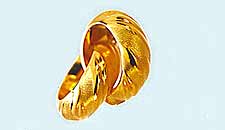 |
|
Left
over traces eft soap anb water unber'trre jewthiy . breaks the protective
shield of the skin and allows nickel '. to come into
direct contact with the skin. Earrings and \ finger rings
are most likely to hold water after the bath or ' while doing the
household work. This is the reason why;some people experience awful
smell in the earrings once it is removed from the ear. Being extra
cautious while taking bath or washing hands can avoid these problems.
Always ensure to wipe off the soap and water from the body fully. |
Other
precautions that can be taken to avoid allergy are:
|
 |
|
1.
Ask your jeweler if the piece can be coated with . a new layer of
metal or a clear protective film.
2. Apply several coats of clear or
transparent nail polish at the back of the ring. In same way nail
polish can be applied to other jewelry items too.
3. People who are highly sensitive to nickel should get their jewelries
lacquered, coated or plated with palladium.
4. Watch for
jewelry labeled hypo-allergenic. It's formulated for people with
heightened sensitivities to metals.
|
 |
|
5.
Keep your skin dry when wearing jewelry. Apply talcum powder before
wearing the jewelry to prevent the moisture.
6. Wear offending pieces for only
a short time and change the jewelry items more often.
7. Keep your jewelry clean, dry and
tarnish-free keep the jewelry clean and dry.
8. Do not wear tight earrings or rings
or chains; leave little space so that air passes through it. |
Jewelry enhances the beauty and makes
the wearer more charming. Unfortunately, few people have to bear
pain of becoming beautiful as they suffer from the allergy.But,
with these precautions and care the allergy can be avoided and they
can continue to look good by wearing the fascinating jewelry items.
|
| 101
THE DIAMOND AMAZING FACTS |
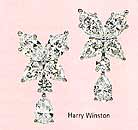 |
|
86.
The custom of wearing a diamond ring on the fourth finger of the
left hand comes from the ancient Egyptians, who believed that the
vena amoris ('vein of love') runs directly from this finger to the
heart.
87.
We have heard about 'PERFECT MARRIAGE', it is with perfect costumes,
makeup, jewelry and many more. Earlier in olden days, many princesses
during their wedding wore diamonds jewelry. They not only wear diamond
jewelry's but they also stud diamonds on their wedding dress, which
established their pride and honor. |
| |
|
|
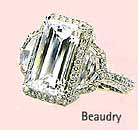 |
|
88.
70% of all brides receive a diamond engagement ring; over 75% of
all first-time brides receive one.
89.
While 5 5 percent of men prefer the element of surprise, 50 percent
of couples choose the diamond engagement ring together.
90. 90% of all grooms receive a wedding
band, one in five receive a diamond wedding band. |
| |
|
|
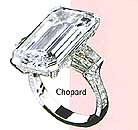 |
|
91. The most popular
style for diamond engagement rings is the classic solitaire (a single-stone
setting). Thirty-four percent of diamond engagement rings sold are
set in a traditional solitaire design, while 22 percent feature a
center stone with two side stones.
92. April's birthstone, diamond is said
to be at its most potent when set in steel. Of course today's diamonds
are set in gold or platinum.
93. Diamond is for engagement and also
the symbol for 60th and 75 th wedding anniversary, for a commitment
to never-ending love. |
| |
|
|
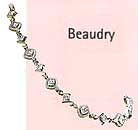 |
|
94.
In 1919 an American physicist, Marcel Tolkowsky, calculated the
best theoretical compromise for the cut of a diamond to release
the most beauty and then devised the current pattern for the modern,
round brilliant cut, the most widely used diamond cut in the world.
The typical brilliant- cut diamond has 58 facets; 33 on the crown
(top) and 25 on the pavilion (bottom).
95. A rough diamond will lose 40%
- 70% of its weight in the cutting process
96. Antwerp is the diamond cutting capital
of the world, then Amsterdam , Tel Aviv, New York and London .
|
| |
|
|
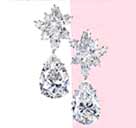 |
|
97.
Two events near the end of the 19th century helped change
the role of diamonds for the next century. First, the discovery
in the 1870s of diamond deposits of unprecedented richness in South
Africa changed diamond from a rare gem to one potentially available
to anyone who could afford it. Before the 1870s diamonds were still
rare, and associated with the aristocracy. In 1871, however, world
annual production, derived primarily from South Africa , exceeded
l million carats for the first time. From then on, diamonds would
be produced at a prodigious rate.
|
| |
|
|
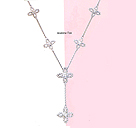 |
|
98. Second, simultaneously, the fall
of Napoleon III in 1871 left the Third Republic of France with a
problematic symbol of monarchy: the French crown jewels largely
reset by Empress Eugenic in the style of the great Louis kings.
In 1887, it was decided to auction the bulk, retaining a few key
objects for the State. It was consumed by newly wealthy capitalists,
particularly in the United States, where a taste and capacity for
opulent consumption was burgeoning. This was an announcement of
the United States as a country prepared to display ist wealth as
well as its power in the new century.
|
| |
|
|
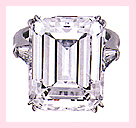 |
|
99. The
first diamond price list was issued in the twelfth century, by an
Arab, Teifaschius. Now the generally-accepted price list is the
Rapaport list, or the 'Rap Sheet', published by Martin Rapaport
in New York.
100. That diamond business is a monopoly with
the supply of gems controlled mainly by a company called De Beers.
In which the primary diamond marketing is largely controlled by
De Beers Consolidated Mines, Ltd. through ist majority control of
the Central Selling Organization (CSO). The CSO sells a large percentage
of mine production to diamond dealers; independent mines sell by
closed bids and through private transactions.
|
101.
Diamonds are not the most expensive gemstones. |
|
|

